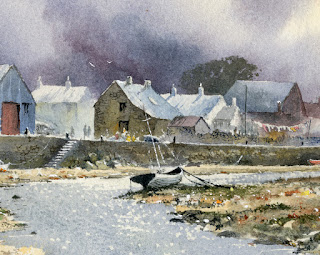 It’s been almost impossible to do much painting or writing lately, thanks to a very happy event. On 22nd February my daughter Catherine gave birth to an absolutely gorgeous little daughter, so for the first time I am now a grandad. She goes by the name of Guinevere, and I can’t wait to paint her. She’s already had a trek across the mountains at around 10,000 feet in the Italian Dolomites, when Catherine was carrying her last July, and as you can see from the photograph she is obviously deep in artistic contemplation.
It’s been almost impossible to do much painting or writing lately, thanks to a very happy event. On 22nd February my daughter Catherine gave birth to an absolutely gorgeous little daughter, so for the first time I am now a grandad. She goes by the name of Guinevere, and I can’t wait to paint her. She’s already had a trek across the mountains at around 10,000 feet in the Italian Dolomites, when Catherine was carrying her last July, and as you can see from the photograph she is obviously deep in artistic contemplation.
For my own contemplation I’m beginning to put together thoughts and images for my next book about coastal scenery, for which I have a whole host of new work from both the UK and abroad. My Arctic book will be coming out in June, so there will be more on that later on, but it’s important to keep thinking ahead when you work on various projects. The sea has always been one of my favourite subjects, and the coastal book will be the fourth and last in my current series of how-to-paint books.
Before I go, just a quick tip on painting those boaty things – you don’t always have to insert a complicated harbour background into the composition, or indeed any sort of complex background. In this watercolour sketch I have simply brought the atmospheric sky down to meet the sand, and left it at that. Just because something is there, you don’t have to include it!
And don’t forget – if you want to get views of a boat from all angles it pays to take along a pair of wellies before you dive into that lovely mud….




 large part of the painting just to illustrate the advantages of the sort of effect you can achieve by concentrating the light into a small part of the composition. The turbulent sea gave sketching on the boat a refreshing spontaneity, although it was not long before it was not just the sea that was starting to turn a bit green……
large part of the painting just to illustrate the advantages of the sort of effect you can achieve by concentrating the light into a small part of the composition. The turbulent sea gave sketching on the boat a refreshing spontaneity, although it was not long before it was not just the sea that was starting to turn a bit green……